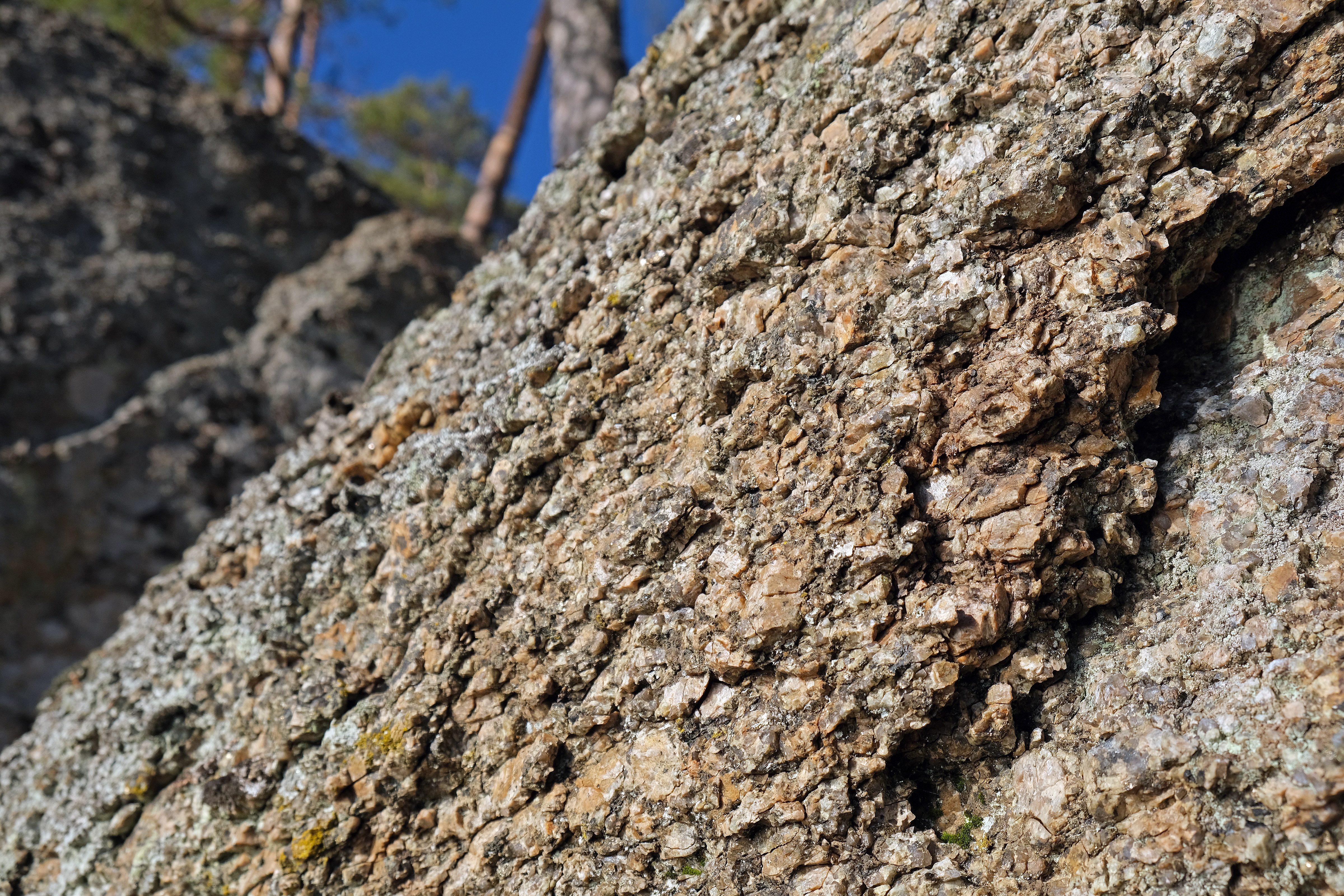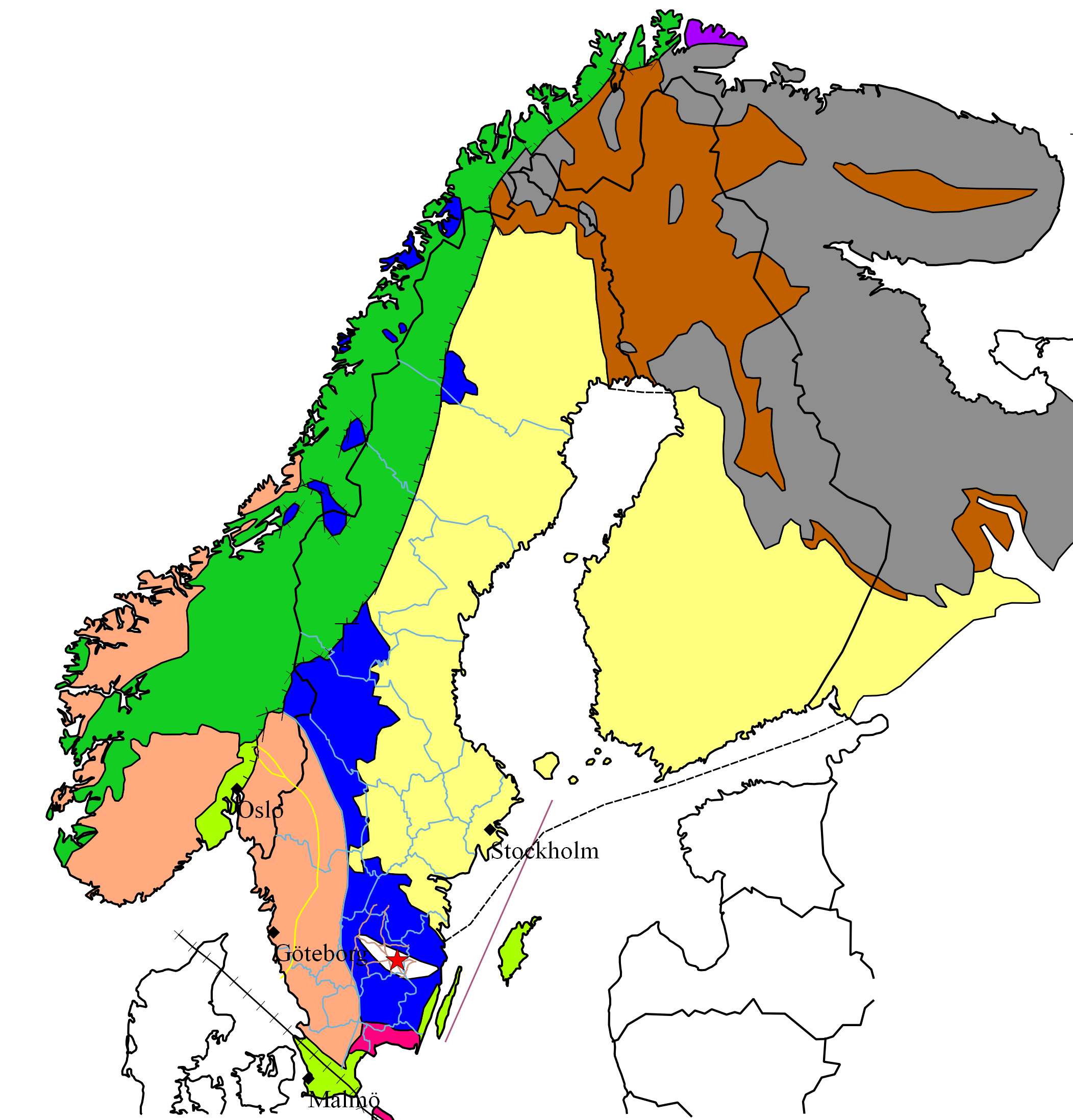|
Rapakivi Granite
Rapakivi granite is a hornblende-biotite granite containing large round crystals of orthoclase each with a rim of oligoclase (a variety of plagioclase). The name has come to be used most frequently as a textural term where it implies plagioclase rims around orthoclase in plutonic rocks. Rapakivi is a Finnish compound of "rapa" (meaning "mud" or "sand") and "kivi" (meaning "rock"), because the different heat expansion coefficients of the component minerals make exposed rapakivi crumble easily into sand. Rapakivi was first described by Finnish petrologist Jakob Sederholm in 1891. Since then, southern Finland's rapakivi granite intrusions have been the type locality of this variety of granite. Occurrence Rapakivi is a fairly uncommon type of granite, but has been described from localities in North and South America (Illescas Batholith, Uruguay, Rondônia, Brazil) parts of the Baltic Shield, southern Greenland, southern Africa, India and China. Most of these examples are found ... [...More Info...] [...Related Items...] OR: [Wikipedia] [Google] [Baidu] |
South America
South America is a continent entirely in the Western Hemisphere and mostly in the Southern Hemisphere, with a relatively small portion in the Northern Hemisphere at the northern tip of the continent. It can also be described as the southern Subregion#Americas, subregion of a single continent called Americas, America. South America is bordered on the west by the Pacific Ocean and on the north and east by the Atlantic Ocean; North America and the Caribbean Sea lie to the northwest. The continent generally includes twelve sovereign states: Argentina, Bolivia, Brazil, Chile, Colombia, Ecuador, Guyana, Paraguay, Peru, Suriname, Uruguay, and Venezuela; two dependent territory, dependent territories: the Falkland Islands and South Georgia and the South Sandwich Islands; and one administrative division, internal territory: French Guiana. In addition, the ABC islands (Leeward Antilles), ABC islands of the Kingdom of the Netherlands, Ascension Island (dependency of Saint Helena, Asce ... [...More Info...] [...Related Items...] OR: [Wikipedia] [Google] [Baidu] |
Phanerozoic
The Phanerozoic Eon is the current geologic eon in the geologic time scale, and the one during which abundant animal and plant life has existed. It covers 538.8 million years to the present, and it began with the Cambrian Period, when animals first developed hard shells preserved in the fossil record. The time before the Phanerozoic, called the ''Precambrian'', is now divided into the Hadean, Archaean and Proterozoic eons. The time span of the Phanerozoic starts with the sudden appearance of fossilised evidence of a number of animal phyla; the evolution of those phyla into diverse forms; the emergence and development of complex plants; the evolution of fish; the emergence of insects and tetrapods; and the development of modern fauna. Plant life on land appeared in the early Phanerozoic eon. During this time span, tectonic forces which move the continents had collected them into a single landmass known as Pangaea (the most recent supercontinent), which then separated int ... [...More Info...] [...Related Items...] OR: [Wikipedia] [Google] [Baidu] |
Archean
The Archean Eon ( , also spelled Archaean or Archæan) is the second of four eon (geology), geologic eons of History of Earth, Earth's history, representing the time from . The Archean was preceded by the Hadean Eon and followed by the Proterozoic. The Earth during the Archean was mostly a water world: there was continental crust, but much of it was under an ocean deeper than today's ocean. Except for some trace minerals, today's oldest continental crust dates back to the Archean. Much of the geological detail of the Archean has been destroyed by subsequent activity. The Earliest known life forms, earliest known life started in the Archean. Life was simple throughout the Archean, mostly represented by shallow-water microbial mats called stromatolites, and the atmosphere lacked free oxygen. Etymology and changes in classification The word ''Archean'' comes from the Greek word (), meaning 'beginning, origin'. It was first used in 1872, when it meant 'of the earliest geological ... [...More Info...] [...Related Items...] OR: [Wikipedia] [Google] [Baidu] |
Metamorphic Rock
Metamorphic rocks arise from the transformation of existing rock to new types of rock in a process called metamorphism. The original rock ( protolith) is subjected to temperatures greater than and, often, elevated pressure of or more, causing profound physical or chemical changes. During this process, the rock remains mostly in the solid state, but gradually recrystallizes to a new texture or mineral composition. The protolith may be an igneous, sedimentary, or existing metamorphic rock. Metamorphic rocks make up a large part of the Earth's crust and form 12% of the Earth's land surface. They are classified by their protolith, their chemical and mineral makeup, and their texture. They may be formed simply by being deeply buried beneath the Earth's surface, where they are subject to high temperatures and the great pressure of the rock layers above. They can also form from tectonic processes such as continental collisions, which cause horizontal pressure, friction, and di ... [...More Info...] [...Related Items...] OR: [Wikipedia] [Google] [Baidu] |
Proterozoic
The Proterozoic () is a geological eon spanning the time interval from 2500 to 538.8million years ago. It is the most recent part of the Precambrian "supereon". It is also the longest eon of the Earth's geologic time scale, and it is subdivided into three geologic eras (from oldest to youngest): the Paleoproterozoic, Mesoproterozoic, and Neoproterozoic. The Proterozoic covers the time from the appearance of oxygen in Earth's atmosphere to just before the proliferation of complex life (such as trilobites or corals) on the Earth. The name ''Proterozoic'' combines two forms of ultimately Greek origin: meaning 'former, earlier', and , 'of life'. The well-identified events of this eon were the transition to an oxygenated atmosphere during the Paleoproterozoic; the evolution of eukaryotes; several glaciations, which produced the hypothesized Snowball Earth during the Cryogenian Period in the late Neoproterozoic Era; and the Ediacaran Period (635 to 538.8 Ma) which is cha ... [...More Info...] [...Related Items...] OR: [Wikipedia] [Google] [Baidu] |
China
China, officially the People's Republic of China (PRC), is a country in East Asia. It is the world's List of countries and dependencies by population, most populous country, with a Population of China, population exceeding 1.4 billion, slightly ahead of India. China spans the equivalent of five time zones and Borders of China, borders fourteen countries by land, the List of countries and territories by land borders, most of any country in the world, tied with Russia. Covering an area of approximately , it is the world's third List of countries and dependencies by area, largest country by total land area. The country consists of 22 provinces of China, provinces, five autonomous regions of China, autonomous regions, four direct-administered municipalities of China, municipalities, and two special administrative regions of China, Special Administrative Regions (Hong Kong and Macau). The national capital is Beijing, and the List of cities in China by population, most populous cit ... [...More Info...] [...Related Items...] OR: [Wikipedia] [Google] [Baidu] |
India
India, officially the Republic of India ( Hindi: ), is a country in South Asia. It is the seventh-largest country by area, the second-most populous country, and the most populous democracy in the world. Bounded by the Indian Ocean on the south, the Arabian Sea on the southwest, and the Bay of Bengal on the southeast, it shares land borders with Pakistan to the west; China, Nepal, and Bhutan to the north; and Bangladesh and Myanmar to the east. In the Indian Ocean, India is in the vicinity of Sri Lanka and the Maldives; its Andaman and Nicobar Islands share a maritime border with Thailand, Myanmar, and Indonesia. Modern humans arrived on the Indian subcontinent from Africa no later than 55,000 years ago., "Y-Chromosome and Mt-DNA data support the colonization of South Asia by modern humans originating in Africa. ... Coalescence dates for most non-European populations average to between 73–55 ka.", "Modern human beings—''Homo sapiens''—originated in Africa. Th ... [...More Info...] [...Related Items...] OR: [Wikipedia] [Google] [Baidu] |
Africa
Africa is the world's second-largest and second-most populous continent, after Asia in both cases. At about 30.3 million km2 (11.7 million square miles) including adjacent islands, it covers 6% of Earth's total surface area and 20% of its land area.Sayre, April Pulley (1999), ''Africa'', Twenty-First Century Books. . With billion people as of , it accounts for about of the world's human population. Africa's population is the youngest amongst all the continents; the median age in 2012 was 19.7, when the worldwide median age was 30.4. Despite a wide range of natural resources, Africa is the least wealthy continent per capita and second-least wealthy by total wealth, behind Oceania. Scholars have attributed this to different factors including geography, climate, tribalism, Scramble for Africa, colonialism, the Cold War, neocolonialism, lack of democracy, and corruption. Despite this low concentration of wealth, recent economic expansion and the large and young ... [...More Info...] [...Related Items...] OR: [Wikipedia] [Google] [Baidu] |
Greenland
Greenland ( kl, Kalaallit Nunaat, ; da, Grønland, ) is an island country in North America that is part of the Kingdom of Denmark. It is located between the Arctic and Atlantic oceans, east of the Canadian Arctic Archipelago. Greenland is the world's largest island. It is one of three constituent countries that form the Kingdom of Denmark, along with Denmark and the Faroe Islands; the citizens of these countries are all citizens of Denmark and the European Union. Greenland's capital is Nuuk. Though a part of the continent of North America, Greenland has been politically and culturally associated with Europe (specifically Norway and Denmark, the colonial powers) for more than a millennium, beginning in 986.The Fate of Greenland's Vikings , by Dale Mackenzie Brown, ''Archaeological Institute of America ... [...More Info...] [...Related Items...] OR: [Wikipedia] [Google] [Baidu] |
Baltic Shield
The Baltic Shield (or Fennoscandian Shield) is a segment of the Earth's crust belonging to the East European Craton, representing a large part of Fennoscandia, northwestern Russia and the northern Baltic Sea. It is composed mostly of Archean and Proterozoic gneisses and greenstone which have undergone numerous deformations through tectonic activity. It contains the oldest rocks of the European continent with a thickness of 250–300 km. The Baltic Shield is divided into five ''provinces'': the Svecofennian and Sveconorwegian (or Southwestern gneiss) provinces in Fennoscandia, and the Karelian, Belomorian and Kola provinces in Russia. The latter three are divided further into several ''blocks'' and ''complexes'' and contain the oldest of the rocks, at 2500-3100 Ma (million years) old. The youngest rocks belong to the Sveconorwegian province, at 900-1700 Ma old. Thought to be formerly part of an ancient continent, the Baltic Shield grew in size through collisions with ... [...More Info...] [...Related Items...] OR: [Wikipedia] [Google] [Baidu] |
Precambrian Research
''Precambrian Research'' is a peer-reviewed scientific journal covering the geology of the Earth and its planetary neighbors. It is published by Elsevier and, , the editors-in-chief are V. Pease (Stockholm University) and G.C. Zhao (University of Hong Kong). It was established in 1974. According to the ''Journal Citation Reports'', the journal has a 2013 impact factor The impact factor (IF) or journal impact factor (JIF) of an academic journal is a scientometric index calculated by Clarivate that reflects the yearly mean number of citations of articles published in the last two years in a given journal, as ... of 6.023. References External links * * Geology journals Elsevier academic journals English-language journals Publications established in 1974 {{geology-journal-stub ... [...More Info...] [...Related Items...] OR: [Wikipedia] [Google] [Baidu] |



